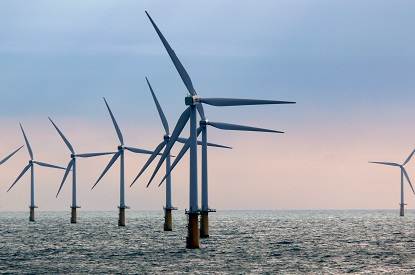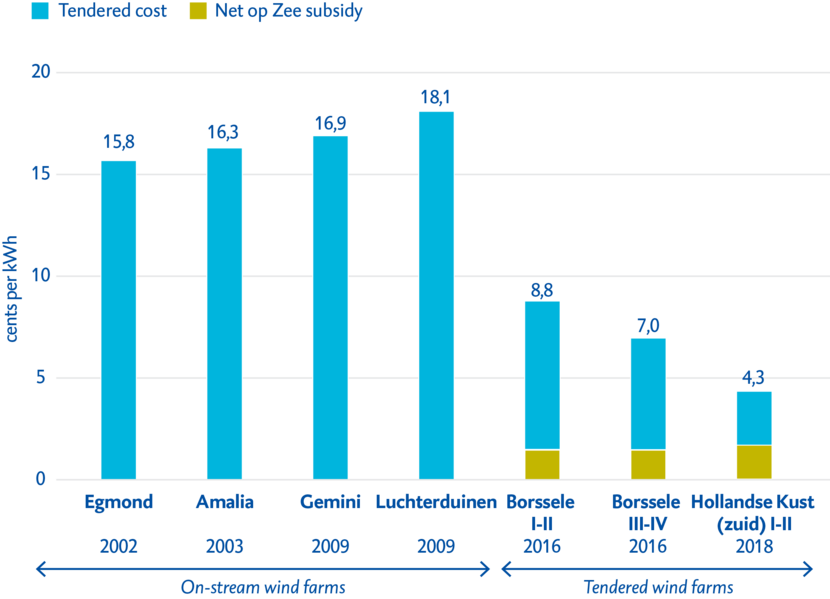Unsubsidised wind farms unlikely in the near future, despite sharp fall in costs
The cost of offshore wind energy is projected to fall spectacularly. Unsubsidised offshore wind farms, however, are unlikely in the near future, according to a report issued by the Netherlands Court of Audit, Focus on the Cost of Offshore Wind Energy.

The Court of Audit’s report was prompted by claims made by the Minister of Economic Affairs and Climate Policy that the cost of offshore wind energy would fall faster and further than expected and that the first wind farms in the world to be built without a subsidy would be erected off the coast of the Netherlands. The Court of Audit investigated whether these claims were true. It also looked into the causes of the fall in costs.
Wind energy still subsidised
The audit found that the ambition of reducing the cost of offshore wind energy by 40% between 2013 and 2023 was within reach. The cost quoted in the winning tender for the Hollandse Kust (zuid) wind farm, which was awarded this year and is due to come on stream in 2022, is 70% lower than estimated in 2013. Without subsidies, however, offshore wind farms cannot supply energy to the national transmission grid. The government provides financial support by subsidising the cost of connecting offshore wind parks to the national transmission grid. The wind farms off the Dutch coast that will come on stream in 2022 will therefore not be the ‘first wind farms in the world to be built without subsidy’, as the Minister of Economic Affairs and Climate Policy wrote to the House of Representatives in March this year.
Government paying for Net op Zee offshore grid
The Court of Audit refers in its report to the subsidy awarded to the Net op Zee grid, which feeds the energy generated offshore into the onshore electricity grid. The national grid operator, TenneT, a state owned enterprise, receives a subsidy for installing and maintaining Net op Zee. A subsidy of €4 billion has been set aside for it to connect the wind farms that will be built up to 2023. The energy that the Hollandse Kust (zuid) wind farm will generate as from 2022 will cost 4.3 cents per kWh. The subsidy paid for Net op Zee is equal to more than a third of this price.
The Court of Audit refers in its report to the subsidy awarded to the Net op Zee grid, which feeds the energy generated offshore into the onshore electricity grid. The national grid operator, TenneT, a state owned enterprise, receives a subsidy for installing and maintaining Net op Zee. A subsidy of €4 billion has been set aside for it to connect the wind farms that will be built up to 2023. The energy that the Hollandse Kust (zuid) wind farm will generate as from 2022 will cost 4.3 cents per kWh. The subsidy paid for Net op Zee is equal to more than a third of this price.
Connection costs can rise
The Court of Audit also points out that the cost of connecting the wind farms may increase between now and 2030. TenneT has warned the Minister of Economic Affairs and Climate Policy that if there are any setbacks in the intervening period the €4 billion available now might not be enough. It also looks as though connection costs for wind farms that are built between 2023 and 2030 will be considerably higher, between €5 and €6 billion. The main reason for this is that the farms will be considerably further offshore. The minister still has to take a decision on how they will be financed.
Focus audit
The audit of the cost of offshore wind energy is a new type of audit developed by the Court. It looks at a current event, beginning with a strictly defined question and carried out over a relatively short period of time. No recommendations are made.
Cost of offshore wind energy: modest increase followed by spectacular fall
